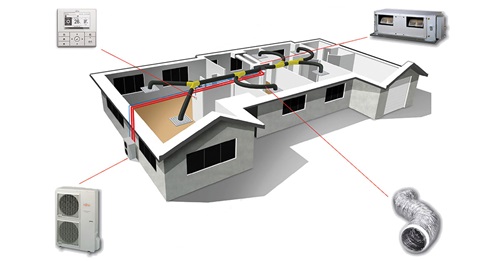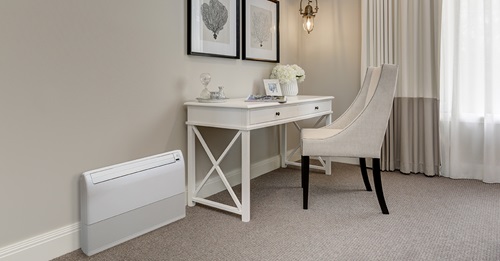What Is Stale Air & How Can You Get Rid Of It?

What is Stale Air?
When air sits for an extended period in a room or area with no circulation or ventilation, it becomes stale. Stale air is no longer fresh and often carries an odour or feels stuffy. This is unpleasant in any season, however when Australians spend more time indoors due to really hot or cold weather, they may notice the air becoming stale, and be impacted by it more. In fact, research shows that Australians spend 90 per cent of their time indoors.1
1. https://www.dcceew.gov.au/environment/protection/air-quality/indoor-air
Stale air may harbour contaminants that have no chance of escaping 2. . It is a good idea to address this issue quickly as stale air may indicate that a room is retaining moisture in walls, ceilings, or floors. If untreated, this can cause mould and mildew, and subsequently lead to health issues.3.
2.https://www.epa.gov/sites/default/files/2014-08/documents/moisture-control.pdf
3.https://www.health.nsw.gov.au/environment/factsheets/Pages/mould.aspx
What Causes Stale Air in Homes?
There are a number of factors that can cause stale and stuffy air in your home, including:
Inadequate ventilation. If little to no air is allowed to enter the room, there may be a buildup of airborne pollutants and particles that could lead to bad odours
High humidity levels. High ambient humidity can contribute to stuffy air inside your home. It may also promote the growth of mould and mildew on indoor surfaces.
Poor air circulation. A lack of airflow in and around the room causes stagnation and allows stale air pockets to form
Buildup of contaminants. Cooking, cleaning and personal hygiene products can all release pollutants into the air, which become trapped in the room if air is not allowed to circulate
Ineffective filtration. Air conditioners with poorly maintained filtration systems can fail to remove pollutants from the air during use.
How Do You Remove Stale Air From Your Home?
There are various ways that indoor air quality can be improved, which can help manage the health of everyone in the home or office. Here are some tips to help remove stale air and keep indoor air quality at its best.
Run the air conditioner
Air conditioning allows you to control temperature and assist with humidity levels. Fujitsu General air conditioning units offer a ‘dry mode’ function. In dry mode, the fan operates at a low speed drawing air through the air conditioning unit to remove humidity (moisture). Fujitsu General’s Lifestyle Wall Mounted Split air conditioning systems also include an apple-catechin filter which captures fine dust, invisible mould spores and harmful microorganisms that are absorbed onto the filter. It is highly recommended that you maintain your air conditioner by keeping the filters clean and the air conditioning system periodically serviced every one to two years depending on usage by a licensed technician.
Open doors and windows
When the air conditioning system is off, a simple way to improve the indoor air quality is to open doors and windows to let the air circulate. By moving the stale air you are replacing the oxygen and avoiding mould growth by reducing condensation.
Cleaning up
Staying on top of household cleaning can be difficult, but it can significantly help to avoid stale air and the potential health risks. Carpets and rugs can harbour chemicals and allergens such as dust mites, some of which can become airborne. Dusting and vacuuming regularly will help to minimise these circulating around the home. Additionally, wiping down benches and bathrooms can remove mould spores that may impair your air quality.
How Do You Keep Stale and Stuffy Air Out?
Keeping the air inside your home fresh, clean and safe is important to ensure both the comfort and the wellbeing of you and your family. Completing the points listed above on a regular basis will help reduce the chance of stale air from impacting your home.
If the air is stale inside your home, try to increase ventilation to all areas of your home. This will help to dilute pollutants and remove stale air from your home. Using your air conditioner to reduce humidity and filter out harmful particulate matter can also improve the air quality inside your home.
Ensuring these issues are addressed will help address the presence of stale and stuffy air in your home, contributing to a safer and more comfortable living environment.
Keep Your Air Conditioner Clean
Routine maintenance is essential to ensure your air conditioner runs efficiently,. You should clean or replace your air conditioner’s filter every 1-3 months, or more often if you are using your air conditioner regularly. You should also have the unit professionally inspected by a qualified technician at least once a year, to ensure the coils and ducts are both clean, and free of mould or pollutants.
Consider Extra Measures
If the air is stale inside your home even after implementing the tips outlined above, there are some extra measures that can be taken to combat it.
Indoor plants, for example, absorb toxins in the air and release oxygen 4. . Placing indoor plants in stale air hotspots can clean the air inside your home, providing relief from the uncomfortable stuffiness.
4. https://ntrs.nasa.gov/archive/nasa/casi.ntrs.nasa.gov/19930073077.pdf
Installing a smart thermostat and/or air quality monitor in your home can further help you control the indoor air quality, allowing you to use your air conditioner to more effectively combat stuffy air.
You can also check your home’s insulation, as poorly or uninsulated rooms can allow pollutants in from outside. Ensuring there are no leaks in your insulation will also help your air conditioner to work more efficiently.
To ensure air is circulated throughout your home, you may also wish to use ceiling fans alongside your air conditioner.
Contact Fujitsu General for more tips on how to use your air conditioning system to ensure the air inside your home stays fresh and clean.


.tmb-tmb420.jpg?sfvrsn=5c4be2e1_1)


